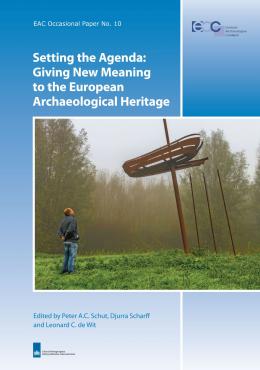Setting the Agenda: Giving New Meaning to the European Archaeological Heritage

Setting the Agenda: Giving New Meaning to the European Archaeological Heritage
| 10 850 Ft |
| Price |
European Archaeological Council Occasional Paper No. 10
Budapest, Archaeolingua, 2015
Keménykötés | Hardcover
170 oldal, színes és fekete-fehér illusztrációkkal | 170 pages with colored and grayscale images
ISBN 978 963 9911 64 2
The digital version of the book is available in pdf on the EAC website.
Table of Contents // Tartalomjegyzék
More than two decades after the signing of the Valletta Convention the time is ripe to draw up a new agenda for how Europe should manage its archaeological heritage. With this purpose in mind, the EAC organised two symposiums that were attended by heritage managers from 25 European countries. At the first symposium in Saranda, Albania, we looked back at twenty years of ‘Valletta’, identifying its benefits, problems and challenges. The results of these discussions can be found in EAC Occasional Paper No. 9.
The second symposium was held in Amersfoort, the Netherlands, and took the form of a working conference. The results are published in this volume, which largely comprises the Amersfoort Agenda for managing the archaeological heritage in Europe. This agenda ties in with the ideas of the Council of Europe’s Faro Convention on the Value of Cultural Heritage for Society (2005). A link is also made with the ideas of the European Union, as expressed in the Conclusions on Cultural Heritage adopted by the Council of the European Union (2014) and a Communication adopted by the European Commission (2014). The zeitgeist calls for an acknowledgement of the multiple values of archaeological heritage for society and recognises the potential role of archaeological heritage in sustainable development.
The Amersfoort Agenda has three themes: 1. Embedding archaeology in society, 2. Dare to choose, and 3. Managing the sources of European history. The various articles in this book are organised under these themes, which they explore in greater depth. Reports of the break-out sessions have also been included so that readers can follow the discussions that have led to the Amersfoort Agenda.
| |
|
|
1067 Budapest, Teréz krt. 13. |
|
|
|
|
About us
The Archaeolingua Foundation and Publisher is involved in publishing series and standalone publications in the disciplines of archaeology, linguistics, historic sciences and heritage protection for over 25 years.
Learn more
Publishing
We publish both as standalone editions and as a volume of a professional series.
Learn more
Contact us
Archaeolingua Foundation

